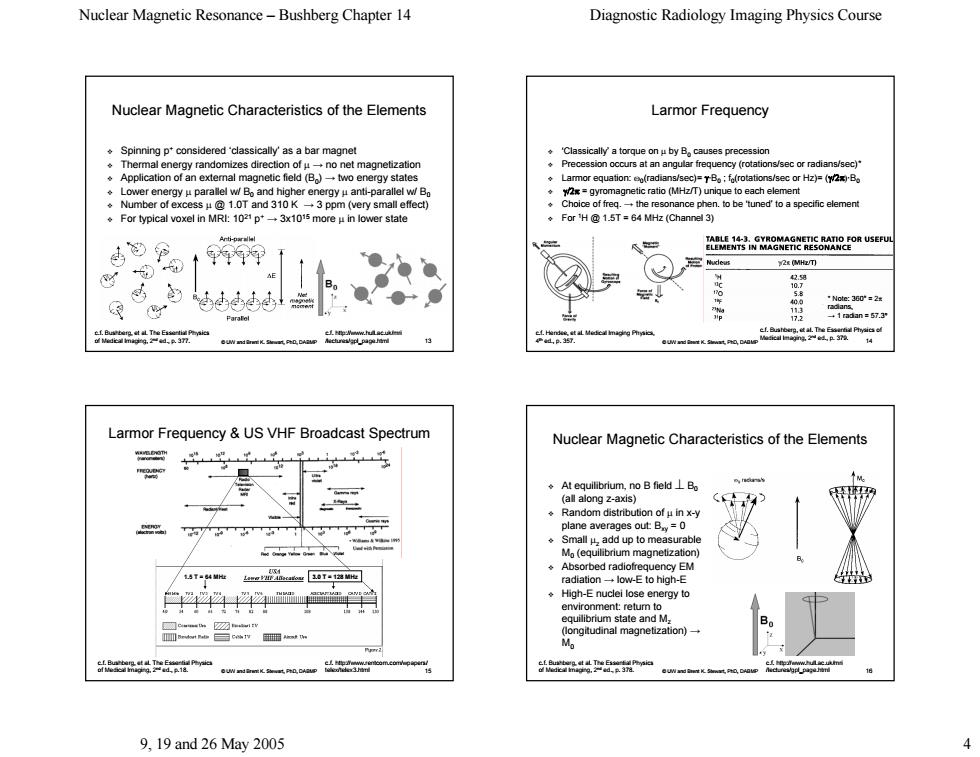正在加载图片...

Nuclear Magnetic Resonance-Bushberg Chapter 14 Diagnostic Radiology Imaging Physics Course Nuclear Magnetic Characteristics of the Elements Larmor Frequency .Spinning p*considered 'classically'as a bar magnet 'Classically a torque on u by B causes precession 。Thermal energy randomizes direction ofμ→no net magnetization Precession occurs at an angular frequency(rotations/sec or radians/sec) .Application of an extemal magnetic field(B)-two energy states Larmor equation:eo(radians/sec)=TB:fo(rotations/sec or Hz)=(W2x)B ·Lower energy-parallel wB 2=gyromagnetic ratio(MHz/T)unique to each element 。Number ofe cess u 1.0T and 310K-3 pp very small effect) Choice of freg.-the resonance phen.to be 'tuned'to a specific element For typical voxel in MRI:102p →3x105moreμn lower state For 'H @1.5T =64 MHz (Channel 3) EMENT IN MAGNETIC ESOMANCEOR USEFU Y2s (MHz/T) radan =57.3 Larmor Frequency US VHF Broadcast Spectrum Nuclear Magnetic Characteristics of the Elements ◆At equllibrium,no B field⊥B ong z-axis) Random distribution ofin x-y plane averages out B=0 Small H add up to measurable Mo(equilibrium magnetization) .Absorbed radiofrequency EM radiation一→low-E to high-E 424%4% .High-E nuclei lose energy to environment:retumn to equilibrum state and M. (longitudinal magnetization) Bo 18 9,19and26May2005 Nuclear Magnetic Resonance – Bushberg Chapter 14 Diagnostic Radiology Imaging Physics Course 9, 19 and 26 May 2005 4 © UW and Brent K. Stewart, PhD, DABMP 13 Nuclear Magnetic Characteristics of the Elements Nuclear Magnetic Characteristics of the Elements Spinning p+ considered ‘classically’ as a bar magnet considered ‘classically’ as a bar magnet Thermal energy randomizes direction of Thermal energy randomizes direction of µ → no net magnetization Application of an external magnetic field (B0) → two energy states Lower energy Lower energy µ parallel w/ B0 and higher energy and higher energy µ anti-parallel parallel w/ B0 Number of excess Number of excess µ @ 1.0T and 310 K @ 1.0T and 310 K → 3 ppm (very small effect) 3 ppm (very small effect) For typical voxel in MRI: 1021 p+ → 3x1015 more µ in lower state c.f. Bushberg, et al. The Essential Physics of Medical Imaging, 2nd ed., p. 377. c.f. http://www.hull.ac.uk/mri /lectures/gpl_page.html © UW and Brent K. Stewart, PhD, DABMP 14 Larmor Frequency Larmor Frequency ‘Classically’ a torque on Classically’ a torque on µ by B0 causes precession Precession occurs at an angular frequency (rotations/sec or radi Precession occurs at an angular frequency (rotations/sec or radians/sec)* Larmor equation: Larmor equation: ω0(radians/sec)= (radians/sec)= γ·B0 ; f0(rotations/sec or Hz)= ( (rotations/sec or Hz)= (γ/2π)·B0 γ/2π = gyromagnetic ratio (MHz/T) unique to each element = gyromagnetic ratio (MHz/T) unique to each element Choice of freq. Choice of freq. → the resonance phen. to be ‘tuned’ to a specific element the resonance phen. to be ‘tuned’ to a specific element For 1H @ 1.5T = 64 MHz (Channel 3) H @ 1.5T = 64 MHz (Channel 3) c.f. Bushberg, et al. The Essential Physics of c.f. Bushberg, et al. The Essential Physics of Medical Imaging, 2nd ed., p. 379. * Note: 360° = 2π radians, → 1 radian = 57.3° c.f. Hendee, et al. Medical Imaging Physics, 4th ed., p. 357. © UW and Brent K. Stewart, PhD, DABMP 15 Larmor Frequency & US VHF Broadcast Spectrum c.f. http://www.rentcom.com/wpapers/ telex/telex3.html 1.5 T = 64 MHz c.f. Bushberg, et al. The Essential Physics of Medical Imaging, 2nd ed., p.18. 3.0 T = 128 MHz © UW and Brent K. Stewart, PhD, DABMP 16 Nuclear Magnetic Characteristics of the Elements Nuclear Magnetic Characteristics of the Elements At equilibrium, no B field At equilibrium, no B field ⊥ B0 (all along z-axis) axis) Random distribution of Random distribution of µ in x-y plane averages out: Bxy = 0 Small µz add up to measurable add up to measurable M0 (equilibrium magnetization) (equilibrium magnetization) Absorbed radiofrequency EM Absorbed radiofrequency EM radiation radiation → low-E to high-E High-E nuclei lose energy to E nuclei lose energy to environment: return to environment: return to equilibrium state and Mz (longitudinal magnetization) (longitudinal magnetization) → M0 c.f. Bushberg, et al. The Essential Physics of Medical Imaging, 2nd ed., p. 378. c.f. http://www.hull.ac.uk/mri /lectures/gpl_page.html